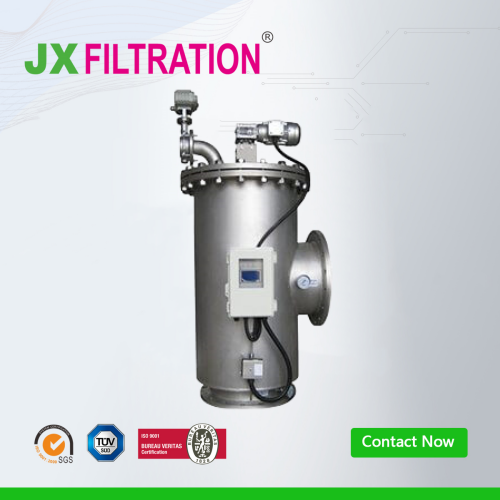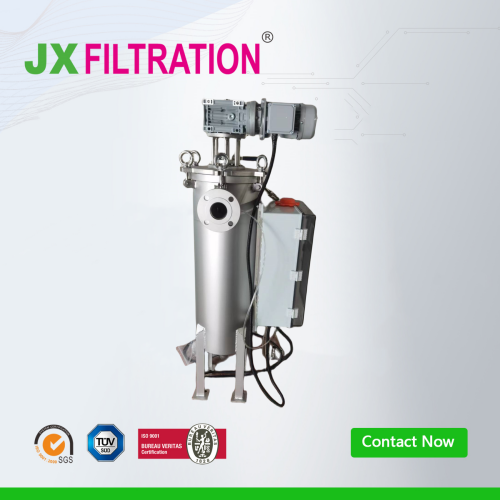Automatic Self Cleaning Filter Technology Introduction
I. Working Principle of Automatic Self Cleaning Filter:
Water enters the filter through the inlet. Initially, it passes through the coarse filter core component to remove larger particles. It then reaches the fine filter mesh, where finer impurities are filtered out. Clean water is discharged through the outlet. During the filtration process, impurities gradually accumulate on the inner layer of the fine filter mesh, creating a pressure difference on both sides.

When this pressure difference reaches a preset value, the automatic cleaning process begins: the drain valve opens, releasing pressure from the hydraulic motor chamber and hydraulic cylinder, allowing water to drain. The pressure inside the hydraulic motor chamber and suction pipe drops significantly, creating a negative pressure that draws impurities from the inner wall of the fine filter mesh through suction nozzles. The impurities are then carried into the hydraulic motor chamber, discharged through the drain valve, creating a suction process.
As water flows through the hydraulic motor, it drives the suction pipe to rotate. The hydraulic cylinder piston moves axially, and the suction cleaner, through a combination of axial and rotational movements, thoroughly cleans the entire surface of the filter mesh. The entire cleaning process lasts for several seconds. The drain valve closes at the end of the cleaning, and the increased water pressure causes the hydraulic cylinder piston to return to its initial position, preparing the filter for the next flushing cycle. During the cleaning process, the filter continues its normal uninterrupted filtering operation.
II. Principle of Automatic Backwash in Automatic Self Cleaning Filter:
Backwash is achieved by the action of hydraulic valves opening and the hydraulic cylinder piston, all controlled by the backwash controller. The backwash controller accurately controls the hydraulic valve and hydraulic cylinder based on the pressure difference values transmitted from the filter inlet and outlet. The controller is powered by the pressure in the pipeline itself.
III. Introduction to Conventional Automatic Self Cleaning Filter:
-
Product Name: Automatic Self Cleaning Filter
-
Product Caliber: DN10-500
-
Product Pressure: 0.6-6.4MPa
-
Product Material: Cast steel, stainless steel, alloy steel, etc.
-
Product Overview:
- Production standards: National standard GB, mechanical standard JB, chemical standard HG, American standards API, ANSI, German standard DIN, Japanese standards JIS, JPI, British standard BS.
- Valve body material: Copper, cast iron, cast steel, carbon steel, WCB, WC6, WC9, 20#, 25#, forged steel, A105, F11, F22, stainless steel, 304, 304L, 316, 316L, chrome-molybdenum steel, low-temperature steel, titanium alloy steel, etc.
- Operating pressure 1.0Mpa-50.0Mpa. Operating temperature: -196℃-650℃.
- Connection methods: Internal thread, external thread, flange, welding, butt welding, socket welding, sleeve joint.
6. Three control methods for Automatic Self Cleaning Filter:
- Pressure difference control
- Timing control
- Manual control
7. Technical parameters of Automatic Self Cleaning Filter:
- Flow range: 40~2400m3/h
- Filtration accuracy: 100~2000μm
- Operating pressure: 0.1~1.6MPa
- Pressure loss: ≤0.016MPa
- Drain valve caliber: DN50mm
- Drain time: 10~60s
- Drain water consumption: <1%
- Applicable temperature: ≤85℃
- Power supply: AC three-phase 380V/50Hz
- Control interface: Digital display, knob, switch
- Filter type: 316 stainless steel
Any Requirements, Contact Us Now!
Kris
Email/Teams: kris@filtrationchina.com
Mobile/Whatsapp/Wechat: +86 18980776200


